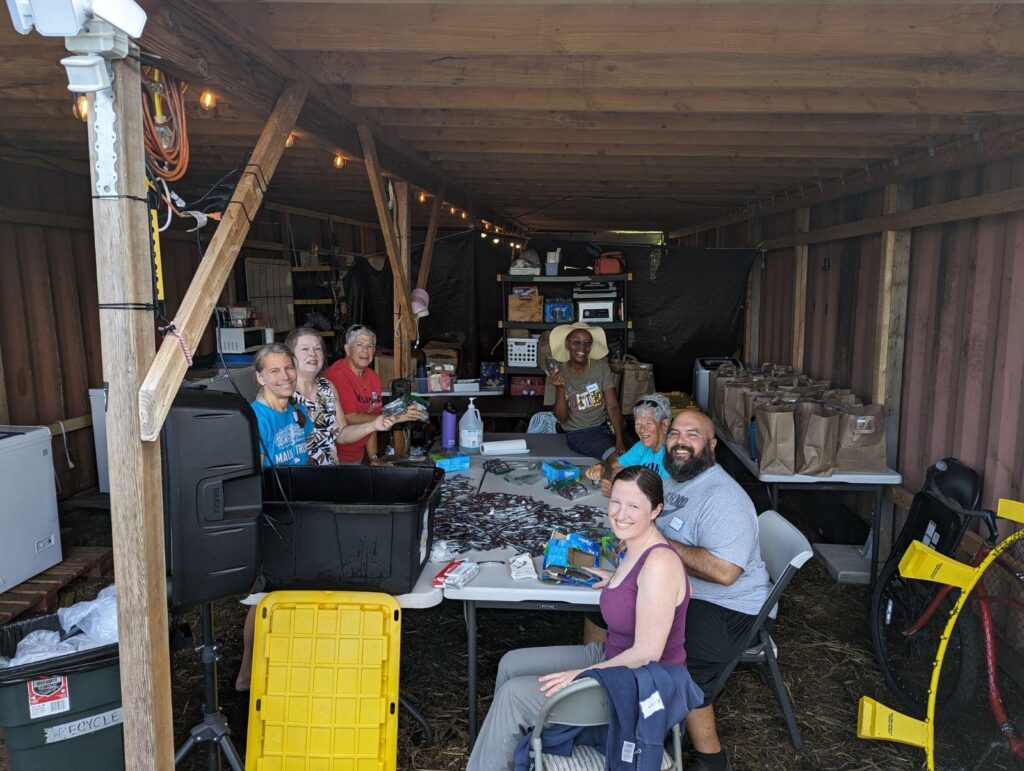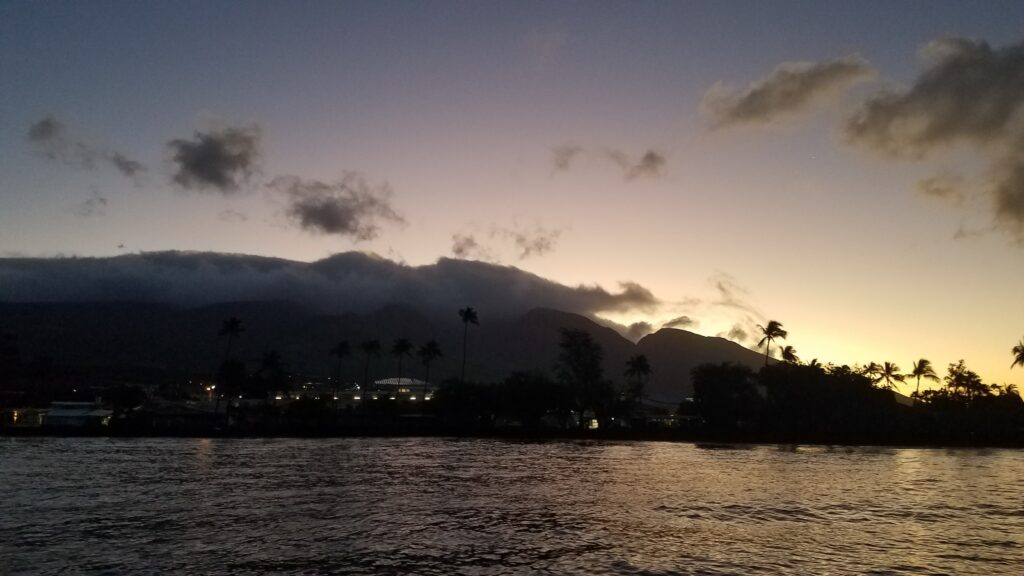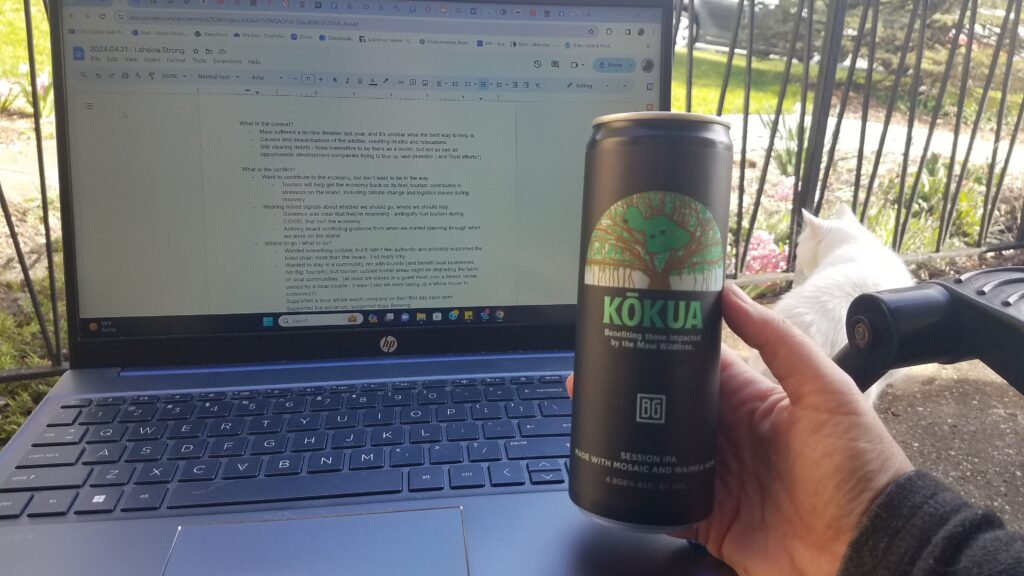I wouldn’t call myself a beach person; I’m definitely not a resort person. I might never have gone to Hawai’i for vacation, and, as someone who avoids tourist locations whenever possible, I certainly never saw myself on Maui. But that’s where we wound up after the week on Oahu for my climate lab had concluded, unsure then – and still unsure now – if we had made the right choice by deciding to visit.
Wildfires and Aftermath
On August 8, 2023, the town of Lahaina on the island of Maui became the site of the deadliest US wildfire in a century, [1] with more than 100 lives lost and approximately 2,600 residents displaced. Tourism was, understandably, shut down in the area while relief efforts took place, though they are still underway as of the writing of this post. Because so many homes were lost, many residents relocated to nearby hotels. Lahaina is one of the biggest tourist locations on the island, and many of the resorts (just across Honoapiilani Highway from devastated residential areas) appeared to be largely untouched by the fire, at least by the time we were there.

I absolutely despise the concept of disaster tourism, but the other end of that spectrum – visiting to help bolster the economy (especially in places where the economy relies on tourism) – can be helpful if done thoughtfully and timed to be beneficial. Christian and I had one such visit to the Pacific coast of Fukushima prefecture in January 2020, nine years after mass evacuations there. [2] Residents there were happy to welcome us and encouraged us to come back in the future – but the two situations were incredibly different, as were the timelines for recovery and reopening.
When I first started researching options for our second week in Hawai’i, I wanted to make an informed decision as to whether we should or shouldn’t go to Maui. Although there were some sources saying that Maui was open for tourists, we would be there a scant six months since the fires. We did not want to be in the way or take up a room that was needed by a displaced family, but we also wanted to help get money flowing back into their local economy to help businesses and families get back on their feet. Of course, the situation was more complicated than it appeared online from 4,500 miles away.
In the opening session of my climate leadership program the week before, [3] we heard from Hawai’i’s governor Josh Green about the factors that led to this disaster in the first place. Poorly maintained utility lines sparked, invasive grasses that were dry from drought conditions caught fire, and Hurricane Dora, 500 miles away, contributed to 70-80 mph winds that spread the fires. [4] He told us that direct damages totaled between $4 and $5 billion dollars, but as a physician, he saw the human cost first-hand.

Photo credit: unnamed volunteer
Should I Stay or Should I Go?
And while Josh Green talked to us about the importance of opening back up and getting tourism dollars flowing once again, it was clear that the tourism industry represents a double-edged sword throughout Hawai’i. For example, prime locations are expensive, and families who have lived in a certain community for generations can get priced out as costs of living rise. In short, increasingly expensive touristy areas exacerbate income inequalities between tourists and residents. On the other hand, families trying to make extra money can capitalize on a property by turning it into a vacation rental, but the increasing ratio of tourists to residents eventually degrades the fabric of a community.
Although the vacation rental concern is one I had heard at home in Pennsylvania, it didn’t occur to me that Hawai’i might have the same problem. Aside from wanting a more genuine experience that involved interacting with locals (instead of other tourists), I also wanted my dollars to benefit a local community, not a multinational hotel chain. For that reason, we rented a room above a small business in a blue-collar neighborhood, ate at local restaurants, and drank at what was clearly a neighborhood bar. People were friendly, if surprised to see us, but I was haunted by the previous week’s discussion about the call for keeping tourists in tourist areas and residents in residential areas.
Perhaps it would have been better for the island if we had stayed in our lane as tourists, but our first foray into Lahaina left an even worse taste in my mouth. We arrived on Maui on our anniversary, and I thought it would be fun to attend a luau that evening. Unfortunately, all of the luaus we could find were run by major hotel chains, and, even more unfortunately, I believed the marketing materials when they described the show as “authentic.” The one I selected for us did not feel authentic; it felt like a Las Vegas-style caricature of Polynesian culture.

We were uncomfortable sitting there among tourists, at an all-you-can-eat buffet that included very little Hawaiian food, watching entertainment instead of experiencing culture, but we also felt like it would be rude to leave. What made the experience worse was seeing the stark difference between the perfectly manicured resort on one side of the road and on the other, wildfire devastation, rubble still uncleared, and Hawaiian flags being flown upside down. Being a tourist in a tourist area never felt more uncomfortable to me.
Giving Back
Before we decided for sure that we were going to Maui, I declared that if we did, I wanted to spend some time volunteering with relief efforts so we weren’t just taking from the communities hosting us. Even that process was more difficult than I expected it to be. While there are organizations that coordinate volunteer relief efforts, Christian and I have now signed up after multiple natural disasters and have never had success – most likely because we are just two people and not part of a larger, longer-term effort. There were some options advertised on Maui, [7] but we had no success until we booked an option through a travel agency. And even then, it seemed like what we did was not a common occurrence.
We didn’t know where we were going or what we’d be doing. The only information we got ahead of time was pickup time and location, plus the phone number of the person who would be driving us to the volunteer location. I might have been a little more skeptical if not for the fact that we went through a travel agency, but when we got to the volunteer site, no one seemed to know that we were coming. Having managed volunteers myself over the years, I know that if they’re not needed, they can just get in the way. Yet again, I wondered if I had made the wrong decision.

In the end, though, we had a good day. We spent our time sorting donations at a resource hub, [9] which provided residents with food and supplies. While packaging instant coffee at a folding table for six hours was not exactly a sexy volunteer activity, it was the right amount of mental and emotional load I needed after a very difficult week with my climate program (and a more difficult few days feeling like I hadn’t made any correct choices about being a tourist on Maui.) We listened to music and got to know some other volunteers, many of whom simply lived in the area and came to help out on a regular basis. They were definitely surprised we took one of our three days on Maui to volunteer.
I want to be clear that every local person we encountered was nice to us. Discomfort that I felt while we were on Maui came from me second-guessing myself, not from anyone insinuating that we were unwelcome. In fact, we were regularly thanked for coming and spending our dollars there. But the question remained in my mind: what is the correct answer, if tourism is both necessary for the economy and harmful for the environment and community? It would be easy for me to say “do your research before you go” in order to maximize benefits and minimize harm, but I did my research, and I felt like I didn’t make the right decisions… but I also don’t know what I would have done differently in retrospect.
Ultimately I think the issue runs deeper than what decisions tourists should make if/when they travel to Hawai’i. I think for an issue as fraught as this one, the answer may be for Hawai’i to reduce its reliance on tourism, which I know sounds completely unreasonable at face value. I can’t say what that would look like in practice, but it was clear from the limited time we were there that the way the tourism industry is being run is not sustainable, and business as usual will continue to harm the place and its people. I will be curious to see how Hawaiian tourism evolves (whether through proactive management or reactive adaptation) in the years to come.

I don’t know whether a return trip is in my future, but if I ever feel like my presence represents a net benefit for Hawai’i, I’ll certainly consider it.
Do you have experiences on the tourist track or off the beaten path on Maui? What were your impressions? I’d love to hear about it in the comments below.
Thanks for reading!
[1] https://www.npr.org/2023/08/15/1193710165/maui-wildfires-deadliest-us-history
[2] https://radicalmoderate.online/i-heart-fukushima-part-1/
[3] https://radicalmoderate.online/climate-lab-hawaii-in-the-classroom/
[4] https://www.nbclosangeles.com/weather-news/how-maui-wildfires-spread-hurricane-dora-drought/3204307/
[5] https://radicalmoderate.online/climate-lab-hawaii-in-the-field/
[6] https://www.makaiadventures.com/
[7] https://www.gohawaii.com/islands/maui/malama-maui/voluntourism
[10] https://mauibrewingco.com/kokua/
1 Comment
Rebecca J Steele · April 21, 2024 at 7:40 pm
I am sorta speechless. Mixed feelings. It just makes my heart ponder the devastating situations that happen in this world. It’s just sad. I won’t go there but I will pray for the people and their land.
You’r work is so touching. Your heart is so big. You are truly a blessing to so many.